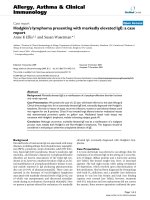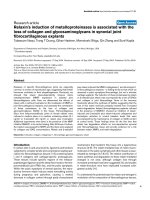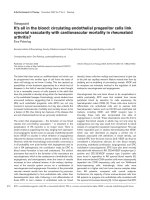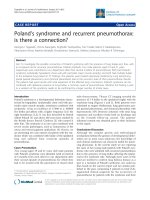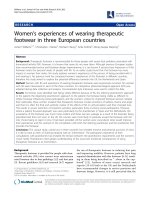Báo cáo y học: "BioAfrica''''s HIV-1 Proteomics Resource: Combining protein data with bioinformatics tools" potx
Bạn đang xem bản rút gọn của tài liệu. Xem và tải ngay bản đầy đủ của tài liệu tại đây (3.96 MB, 14 trang )
BioMed Central
Page 1 of 14
(page number not for citation purposes)
Retrovirology
Open Access
Review
BioAfrica's HIV-1 Proteomics Resource: Combining protein data
with bioinformatics tools
Ryan S Doherty*
1
, Tulio De Oliveira
1
, Chris Seebregts
2
,
Sivapragashini Danaviah
1
, Michelle Gordon
1
and Sharon Cassol
1,3
Address:
1
Molecular Virology and Bioinformatics Unit, Africa Centre for Health and Population Studies, Doris Duke Medical Research Institute,
Nelson R. Mandela School of Medicine, University of KwaZulu-Natal, Durban, South Africa,
2
Biomedical Informatics Research Division, South
African Medical Research Council, Cape Town, South Africa and
3
Department of Medical Virology, University of Pretoria, Pretoria, South Africa
Email: Ryan S Doherty* - ; Tulio De Oliveira - ; Chris Seebregts - ;
Sivapragashini Danaviah - ; Michelle Gordon - ; Sharon Cassol -
* Corresponding author
Abstract
Most Internet online resources for investigating HIV biology contain either bioinformatics tools,
protein information or sequence data. The objective of this study was to develop a comprehensive
online proteomics resource that integrates bioinformatics with the latest information on HIV-1
protein structure, gene expression, post-transcriptional/post-translational modification, functional
activity, and protein-macromolecule interactions. The BioAfrica HIV-1 Proteomics Resource http:/
/bioafrica.mrc.ac.za/proteomics/index.html is a website that contains detailed information about
the HIV-1 proteome and protease cleavage sites, as well as data-mining tools that can be used to
manipulate and query protein sequence data, a BLAST tool for initiating structural analyses of HIV-
1 proteins, and a proteomics tools directory. The Proteome section contains extensive data on
each of 19 HIV-1 proteins, including their functional properties, a sample analysis of HIV-1
HXB2
,
structural models and links to other online resources. The HIV-1 Protease Cleavage Sites section
provides information on the position, subtype variation and genetic evolution of Gag, Gag-Pol and
Nef cleavage sites. The HIV-1 Protein Data-mining Tool includes a set of 27 group M (subtypes A
through K) reference sequences that can be used to assess the influence of genetic variation on
immunological and functional domains of the protein. The BLAST Structure Tool identifies proteins
with similar, experimentally determined topologies, and the Tools Directory provides a
categorized list of websites and relevant software programs. This combined database and software
repository is designed to facilitate the capture, retrieval and analysis of HIV-1 protein data, and to
convert it into clinically useful information relating to the pathogenesis, transmission and
therapeutic response of different HIV-1 variants. The HIV-1 Proteomics Resource is readily
accessible through the BioAfrica website at: />Background
Although the HIV-1 genome contains only 9 genes, it is
capable of generating more than 19 gene products. These
products can be divided into three major categories: struc-
tural and enzymatic (Gag, Pol, Env); immediate-early reg-
ulatory (Tat, Rev and Nef), and late regulatory (Vif, Vpu,
Published: 09 March 2005
Retrovirology 2005, 2:18 doi:10.1186/1742-4690-2-18
Received: 30 September 2004
Accepted: 09 March 2005
This article is available from: />© 2005 Doherty et al; licensee BioMed Central Ltd.
This is an Open Access article distributed under the terms of the Creative Commons Attribution License ( />),
which permits unrestricted use, distribution, and reproduction in any medium, provided the original work is properly cited.
Retrovirology 2005, 2:18 />Page 2 of 14
(page number not for citation purposes)
Vpr) proteins. Tat, Rev and Nef are synthesized from small
multiply-spliced mRNAs; Env, Vif, Vpu and Vpr are gener-
ated from singly-spliced mRNAs, the Gag and Gag-Pol
precursor polyproteins are synthesized from full-length
mRNA. The matrix (p17), capsid (p24) and nucleocapsid
(p7) proteins are produced by protease cleavage of Gag
and Gag-Pol, a fusion protein derived by ribosomal
frame-shifting. Cleavage of Nef generates two different
protein isoforms; one myristylated, the other non-myri-
stylated. The viral enzymes (protease, reverse tran-
scriptase, RNase H and integrase) are formed by protease
cleavage of Gag-Pol. Alternative splicing, together with co-
translational and post-translational modification, leads to
additional protein variability [1].
Phylogenetic analysis, on its own, provides little informa-
tion about the conformational, immunological and func-
tional properties of HIV-1 proteins, but instead, focuses
on the evolution and historical significance of sequence
variants. To understand the clinical significance of genetic
variation, sequence analysis needs to be combined with
methods that assess change in the structural and biologi-
cal properties of HIV-1 proteins. At present, information
and tools for the systematic analysis of HIV-1 proteins are
limited, and are scattered across a wide-range of online
resources [2,3]. To facilitate studies of the biological con-
sequences of genetic variation, we have developed an inte-
grated, user-friendly proteomics resource that integrates
common approaches to HIV-1 protein analysis (Figure 1).
We are currently using this resource to better understand
the structure-function relationships underlying the emer-
gence of antiretroviral drug resistance, and to examine the
process of immune escape from cytotoxic T-lymphocytes
(CTLs).
We have categorized the Proteomics Resource into the fol-
lowing main subject headings (Figure 2 &3):
1. HIV Proteome – Information about structure and
sequence, as well as references and tutorials, for each of
the HIV-1 proteins (Figure 4);
2. HIV-1 Cleavage Sites – Information about the position
and sequence of HIV-1 Gag, Pol and Nef cleavage sites
(Figure 5);
3. HIV Protein Data Mining Tool – Application for detect-
ing the characteristics of HIV-1 M group isolate (subtype
A to K) proteins using information available in public
databases and tools (Figure 6);
4. HIV Structure BLAST – Similarity search for analyzing
HIV protein sequences with corresponding structural data
(Figure 7);
5. Proteomics Online Tools – Directory of data resources
and tools available for both protein sequence and protein
structure analyses of HIV (Figure 8 &9).
The proteome link
In the HIV-1 Proteome section, each of the 19 HIV-1 pro-
teins has a webpage that is divided into six parts: "general
overview", "genomic location", "domains/folds/motifs",
"protein-macromolecule interactions", "primary and sec-
ondary database entries", and "references and recom-
mended readings" (Figure 4). The overview includes a
description of the protein, a list of known isoforms, a rep-
resentative tertiary structure animated image (GIF format)
of the protein and its co-ordinates (PDB format), a link to
chime tutorials, if available, and information about cleav-
age sites, localization, and functional activity. The
genomic location section provides information on the
location of the sequence relative to the reference
sequence, HIV-1
HXB2
[4], sequence data (fasta format),
and information about the length, molecular weight and
theoretical isoelectric point (pI) of the protein. The
domains/folds/motifs section contains information
about functional domains and predicted motifs (glyco-
sylation, myristoylation, amidation, phosphorylation and
cell attachment sites) of HIV-1
HXB2
[4], and provides struc-
tural predictions (secondary structure, transmembrane
regions, low complexity regions, and coiled-coil regions).
The section on protein-macromolecule interactions
includes information on protein complexes, protein-pro-
tein/DNA/RNA interactions, signal-transduction path-
ways, and potential interactions with other pathogens.
The section on primary and secondary databases contains
a list of database entries that are needed to retrieve infor-
mation on protein structure, nucleotide/amino acid
sequence data, protein sequence annotation, proteins
with similar sequence and structure (such as Los Alamos
National Laboratories HIV Sequence Database and the
RCSB Protein Data Bank), as well as information on post-
translational modification and protein-protein interac-
tions. A list of key reviews and publications, used in the
development of the BioAfrica HIV-1 Proteomics Resource,
is provided in the references and recommended readings
section. As an example, the proteome webpage for Tat,
describes how this protein up-regulates HIV-1 gene
expression by interacting with the long-terminal repeat
(LTR) of HIV-1, promoting the elongation phase of viral
transcription, allowing full-length HIV-1 mRNA tran-
scripts to be produced [5,6] (Figure 10). The webpage also
gives information on the structural organization of tat
gene. The mRNA is derived from spliced exons encoded in
two different open reading frames. In HIV-1
HXB2
, these
reading frames are separated by a distance of 2334 nucle-
otides. Some HIV-1 isolates, including HIV-1
HXB2
, contain
an artifact of laboratory strains consisting of a premature
stop codon at position 8424 of exon 2. The presence of
Retrovirology 2005, 2:18 />Page 3 of 14
(page number not for citation purposes)
Site map of BioAfrica's HIV-1 Proteomics Resource, showing the separation of Beginner's and the Advanced area of the web-site, along with all major subject headingsFigure 1
Site map of BioAfrica's HIV-1 Proteomics Resource, showing the separation of Beginner's and the Advanced area of the web-
site, along with all major subject headings.
Retrovirology 2005, 2:18 />Page 4 of 14
(page number not for citation purposes)
Schematic representation of BioAfrica's HIV-1 Proteomics Resource, showing its five major components: the HIV-1 Proteome (General Overview, Domains/Folds/Motifs, Genomic Location, Protein-Macromolecule Interactions, Primary and Secondary Database Entries, and References and Recommended Readings), the HIV-1 Protease Cleavage Sites section, the HIV-1 Protein Data-mining Tool, the HIV-1 BLAST Structure Tool, and the Proteomics Tools Directory (for Beginners and Advanced investigators)Figure 2
Schematic representation of BioAfrica's HIV-1 Proteomics Resource, showing its five major components: the HIV-1 Proteome
(General Overview, Domains/Folds/Motifs, Genomic Location, Protein-Macromolecule Interactions, Primary and Secondary
Database Entries, and References and Recommended Readings), the HIV-1 Protease Cleavage Sites section, the HIV-1 Protein
Data-mining Tool, the HIV-1 BLAST Structure Tool, and the Proteomics Tools Directory (for Beginners and Advanced
investigators).
Retrovirology 2005, 2:18 />Page 5 of 14
(page number not for citation purposes)
this stop codon leads to the synthesis of a truncated form
of Tat that is 86, rather than 101 amino acids in length.
The protein has two different isoforms – one translated
from early-stage multiply spliced mRNA (p14); the other
from singly-spliced mRNA (p16) [7]. Important func-
tional domains include the acidic, amphipathic region (1-
MEPVDPRLEPWKHPGSQPKTA-21; the hydrophobic res-
idues are highlighted in bold, and polar residues are itali-
cized) at the N-terminus of the protein; the cysteine-rich
disulphide bond region (22-CTNCYCKKCCFHCQVC-
37); the core, basic and glutamine-rich region (49-RKKR-
RQRRRAHQNSQTHQASLSKQ-72) that is important for
nuclear localization and TAR-binding activity, and the
RGD cell-attachment site that binds to cellular integrins.
In addition to being expressed in HIV-1-infected cells, Tat
is also released into the extracellular fluid where it acts as
a growth factor for the development of Kaposi's Sarcoma.
Additional information about Tat and its protein-protein
interactions can be found on the proteome page of the
BioAfrica website located at />proteomics/TATprot.html.
Protease cleavage sites link
Post-translational cleavage of the Gag, Gag-Pol and Nef
precursor proteins occurs at the cell membrane during vir-
ion packaging, and is essential to the production of infec-
tious viral particles. Drugs that inhibit this process, the
protease inhibitors (PIs), are the most potent antiretrovi-
ral agents currently available. Thus it is important to col-
lect information, not only on the sequence of protease
enzymes from different HIV-1 subtypes, but also on the
natural polymorphisms and resistance mutations that
The central webpage of BioAfrica's HIV Proteomics Resource />Figure 3
The central webpage of BioAfrica's HIV Proteomics Resource />Retrovirology 2005, 2:18 />Page 6 of 14
(page number not for citation purposes)
may effect their catalytic activities, drug responsiveness,
substrate specificities, and cleavage site characteristics.
Studies have shown that resistance mutations in the pro-
tease of subtype B are associated with impaired proteolytic
processing and decreased enzymatic activity, and that
compensatory mutations at Gag and Gag-Pol cleavage
sites can partially overcome these defects [8]. These find-
ings suggest that variation at protease cleavage sites may
play an important role, not only in regulation of the viral
life cycle, but also in disease progression and response to
therapy.
The cleavage site section of the BioAfrica webpage is the
direct extension of a recent publication in the Journal of
Virology describing the location and variability of pro-
tease cleavage sites [9] (Figure 5). Together, these two
resources provide information on the structure, amino
acid composition, genetic variation and evolutionary his-
tory of protease cleavage sites, and on the natural selection
pressures exerted on these sites. The section also serves as
a baseline for understanding the impact of natural
polymorphisms and resistance mutations on the catalytic
efficiency of the protease enzyme, and on its ability to rec-
ognize and cleave individual Gag, Gag-Pol and Nef sub-
strates. Such studies are important for understanding the
mechanisms underlying the emergence of PI-induced
drug resistance, and for designing alternative, optimized
therapies.
The central webpage of the HIV-1 Proteome section of the BioAfrica website
teome.htmlFigure 4
The central webpage of the HIV-1 Proteome section of the BioAfrica website
teome.html.
Retrovirology 2005, 2:18 />Page 7 of 14
(page number not for citation purposes)
Protein data-mining tools link
The HIV-1 Protein Data-Mining Tool contains twelve
sequence analysis techniques for assessing protein
variability among different strains of HIV-1 (Figure 6).
These tools allow the user to manipulate, analyze and
compare published [9-12] and newly-acquired data in a
user-friendly, hands-on manner. The analysis is initiated
by selecting a particular subset of HIV-1 proteins, either
from the user's database, or from the representative data-
set of group M viruses (subtypes A through K). Using this
dataset, the investigator can then perform a variety of pro-
tein-specific analyses. With a single click of the mouse,
users can download the amino acid sequence in fasta for-
mat; obtain sequence annotations from SwissProt [13] or
GenBank [14]; identify functional motifs using BLOCKS
[15], PROSITE [16] or ProDom [17]; perform similarity
searches using the BLAST program available at Genbank
[18], conduct structural comparisons using the BioAfrica
BLAST Structure program; determine amino acid compo-
sition, predict hydrophobicity and tertiary structure using
the Swiss-Model homology modelling server [19], and
obtain a list of potential protein-macromolecule interac-
tions from the Database of Interacting Proteins (DIP)
[20]. A representative analysis of HIV-1 Tat is shown in
Additional file 1. The selected dataset, consisting of eight
reference strains – four subtype B (HXB2-1983-France, RF-
1983-US, JRFL-1986-US, WEAU160-1990-US) and four
subtype C (92BR025-1992-Brazil, 96BW0502-1996-Bot-
swana, TV002c12-1998-SouthAfrica, TV001c8.5-1998-
SouthAfrica) isolates – were analyzed using PROSITE
The HIV-1 Protease Cleavage Sites section of the BioAfrica website />Figure 5
The HIV-1 Protease Cleavage Sites section of the BioAfrica website
ites.html.
Retrovirology 2005, 2:18 />Page 8 of 14
(page number not for citation purposes)
[16]. As shown in Additional file 1, all eight isolates had
identical amidation, cysteine-rich and myristylation
motifs at amino acid codons 47–50, 22–37 and 44–49,
respectively. Three (75%) of the B isolates contained a sec-
ond myristylation site at codons 42–47, as did three
(75%) subtype C viruses. One (25%) of the C viruses car-
ried an extra GNptGS myristylation motif at position 79–
84. In addition, all four (100%) C isolates contained a
novel myristylation motif, GSeeSK, at amino acid position
83–88, that was not present in four B viruses selected for
study. However, the most striking difference between the
two subtypes was the increased number of phosphoryla-
tion motifs in subtype C relative to B viruses. This
increase, which occurs in cAMP/cGMP-dependent kinase,
protein kinase C (PKC) and casein kinase II (CKII) phos-
phorylation sites, has been reported previously [21], but
the significance of these findings remain to be established.
The analysis also highlighted the atypical nature of the
HIV-1
HXB2
isolate, which, in addition to a premature stop
codon, contained no cAMP/cGMP, PKC or CKII phospho-
rylation sites.
The blast structure tool link
The HIV-1 BLAST Structure Tool facilitates the analysis of
HIV-1 protein structure by allowing for rapid retrieval of
archived structural data stored in the public databases
(Figure 7). Users may input any HIV-1 amino acid
sequence and obtain a list of similar HIV protein
sequences for which structural data have been experimen-
tally determined and deposited into the Protein Data
The central webpage of the HIV-1 Protein Data Mining Tool section of the BioAfrica website, where a specific HIV-1 genomic region is selected to be analyzed />Figure 6
The central webpage of the HIV-1 Protein Data Mining Tool section of the BioAfrica website, where a specific HIV-1 genomic
region is selected to be analyzed />.
Retrovirology 2005, 2:18 />Page 9 of 14
(page number not for citation purposes)
Bank (PDB) [22]. After downloading the data from the
PDB, subsequent structural analyses can be performed
using the software programs and web-servers listed in the
Proteomics Tools Directory. For example, a query using an
amino acid sequence of HIV-1 Integrase protein from
NCBI (gi|15553624|gb|AAL01959.1) results in a list of 54
structural models (ie. PDB_ID|1K6Y) within the PDB.
Each of these structural models can be retrieved from the
PDB, and the most appropriate structural model could be
used for generating a homology model using the query
protein sequence.
The proteomics tools directory link
The HIV-1 Proteomics Tools Directory is divided into two
web pages. The initial webpage is a concise compilation of
some of the most commonly used protein-specific Inter-
net resources (Figure 8). This "beginners" page displays a
short list of websites for each of the following twelve cat-
egories: "protein databases", "specialized viral-protein
databases", "motif and transcription factor databases",
"protein sequence similarity searches", "protein sequence
alignment", "protein sequence prediction tools", "protein
sequence analysis", "protein sequence manipulation",
"protein structure analysis", "molecular modelling tools",
"tutorials", and "downloads". In addition, the Proteomics
Tools Directory has an advanced web page for users who
are looking for alternative, or more specialized, protein
analysis tools (Figure 9). The advanced webpage displays
a list of more than 200 links to different websites and
web-servers. These data sources contain a variety of
The BLAST HIV-1 protein structure similarity search is an online tool that searches for all protein structure data within the PDB that have an amino acid sequence similar to the query sequence />Figure 7
The BLAST HIV-1 protein structure similarity search is an online tool that searches for all protein structure data within the
PDB that have an amino acid sequence similar to the query sequence />.
Retrovirology 2005, 2:18 />Page 10 of 14
(page number not for citation purposes)
information ranging from specialized protein sequence
databases to software programs capable of performing
rigid body protein-protein molecular docking
simulations.
Conclusion
The impending rollout of antiretroviral therapy to mil-
lions of HIV-1-infected people in sub-Saharan Africa pro-
vides a unique opportunity to monitor the efficacy of non-
B treatment programs from their very inception, and to
obtain critical new information for the optimization of
treatment strategies that are safe, affordable and appropri-
ate for the developing world. An integral part of this
massive humanitarian effort will be the collection of large
amounts of clinical and laboratory data, including genetic
information on viral subtype and resistance mutations, as
well as routine CD4+ T-cell counts and viral load meas-
urements. The mere collection of this data, however, does
not ensure that it will be used to its maximum potential.
To achieve full benefit from this explosive source of new
information, the data will need to be appropriately col-
lated, stored, analyzed and interpreted.
The rapidly emerging field of Bioinformatics has the
capacity to greatly enhance treatment (and vaccine) efforts
by serving as a bridge between Medical Informatics and
Experimental Science. By correlating genetic variation and
potential changes in protein structure with clinical risk
factors, disease presentation, and differential response to
treatment and vaccine candidates, it may be possible to
The introductory listing of proteomics resources for HIV research chosen to give a general overview of online tools and data-bases relevant for the analysis of HIV protein data />Figure 8
The introductory listing of proteomics resources for HIV research chosen to give a general overview of online tools and data-
bases relevant for the analysis of HIV protein data />.
Retrovirology 2005, 2:18 />Page 11 of 14
(page number not for citation purposes)
obtain valuable new insights that can be used to support
and guide rationale decision-making, both at the clinical
and public health levels. The HIV-1 Proteomics Resource,
described in this report, is an initial first step in the devel-
opment of improved methods for extracting and analyz-
ing genomics data, converting it into biologically useful
information related to the structure, function and physiol-
ogy of HIV-1 proteins, and for assessing the role these pro-
teins play in disease progression and response to therapy.
The Resource, developed at the Molecular Virology and
Bioinformatics Unit of the Africa Centre of Health and
Population Studies, is a centralized user-friendly database
that is easily accessed through the BioAfrica website at
/>[23].
List of abbreviations used
AA – Amino Acid
BLAST – Basic Local Alignment Search Tool
CKII – casein kinase II
CTLs – cytotoxic T-lymphocytes
DIP – Database of Interacting Proteins
DNA – deoxyribonucleic acid
Env – envelope glycoprotein
The advanced listing of online tools and databases relevant for the analysis of HIV protein data
teomics/proteomics-advanced.htmlFigure 9
The advanced listing of online tools and databases relevant for the analysis of HIV protein data
teomics/proteomics-advanced.html.
Retrovirology 2005, 2:18 />Page 12 of 14
(page number not for citation purposes)
Gag – group-specific antigen polyprotein
GIF – Graphics Interchange Format
HIV – Human Immunodeficiency Virus
HIV-1 – Human Immunodeficiency Virus Type-1
HTTP – Hypertext Transfer Protocol
LTR – long-terminal repeat
mRNA – messenger RNA
NCBI – National Center for Biotechnology Information
A general overview of the HIV-1 Proteome section of the BioAfrica website, as exemplified by the Tat web page http://bioaf
rica.mrc.ac.za/proteomics/TATprot.htmlFigure 10
A general overview of the HIV-1 Proteome section of the BioAfrica website, as exemplified by the Tat web page http://bioaf
rica.mrc.ac.za/proteomics/TATprot.html.
Retrovirology 2005, 2:18 />Page 13 of 14
(page number not for citation purposes)
Nef – negative factor
PDB – Protein Data Bank
pI – isoelectric point
PIs – protease inhibitors
PKC – protein kinase C
Pol – polymerase polyprotein
Rev – ART/TRS anti-repression transactivator protein
RNA – ribonucleic acid
RNase H – ribonuclease H
Tat – transactivating regulatory protein
Vif – virion infectivity factor
Vpr – viral protein R
Vpu – viral protein U
Competing interests
The author(s) declare that they have no competing
interests.
Authors' contributions
RSD created and maintains BioAfrica's HIV proteomics
resource, HIV proteome section, proteomics tools direc-
tory, HIV-1 protein data-mining tool and HIV structure
BLAST tool; performed protein sequence and structural
model analyses; and wrote the manuscript.
TDO conceived and maintains the BioAfrica website, and
continues to oversee its rapid expansion; created the
cleavage sites section; and participated in the design and
implementation of the HIV proteomics resource.
CS participated in the design of the HIV proteomics
resource, with an emphasis on the proteomics tools
directory.
SD participated in the design and creation of the HIV pro-
teome section, with an emphasis on the HIV-1 Tat
protein.
MG participated in the design of the HIV proteomics
resource, with an emphasis on the HIV proteome section.
SC supervised the project, and participated in the design
and implementation of the HIV proteomics resource.
All authors read and approved the final manuscript.
Additional material
Acknowledgements
Development of the Bioafrica HIV-1 Proteomics Resource was supported
by a program grant from the Wellcome Trust U.K. (#061238). The website
is hosted by the South African Medical Research Council (MRC).
References
1. Freed EO: HIV-1 replication. Somat Cell Mol Genet 2001, 26:13-33.
2. Apweiler R, Bairoch A, Wu CH, Barker WC, Boeckmann B, Ferro S,
Gasteiger E, Huang H, Lopez R, Magrane M, Martin MJ, Natale DA,
O'Donovan C, Redaschi N, Yeh LSL: UniProt: The Universal Pro-
tein knowledgebase. Nucleic Acids Res 2004, 32:D115-119.
3. Kuiken C, Korber B, Shafer RW: HIV sequence databases. AIDS
Rev 2003, 5:52-61.
4. Ratner L, Haseltine W, Patarca R, Livak KJ, Starcich B, Josephs SF,
Doran ER, Rafalski JA, Whitehorn EA, Baumeister K: Complete
nucleotide sequence of the AIDS virus, HTLV-III. Nature 1985,
313:277-284.
5. Kao SY, Calman AF, Luciw PA, Peterlin BM: Anti-termination of
transcription within the long terminal repeat of HIV-1 by tat
gene product. Nature 1987, 330:489-493.
6. Feinberg MB, Baltimore D, Frankel AD: The role of Tat in the
human immunodeficiency virus life cycle indicates a primary
effect on transcriptional elongation. Proc Natl Acad Sci USA 1991,
88:4045-4049.
7. Cullen BR: Human Immunodeficiency Virus as a Prototypic
Complex Retrovirus. J Virol 1991, 65:1053-1056.
8. Mammano F, Petit C, Clavel F: Resistance-associated loss of viral
fitness in human immunodeficiency virus type 1: phenotypic
analysis of protease and gag coevolution in protease inhibi-
tor-treated patients. J Virol 1998, 72:7632-7637.
9. de Oliveira T, Engelbrecht S, van Rensburg EJ, Gordon M, Bishop K,
zur Megede J, Barnett SW, Cassol S: Variability at Human Immu-
nodeficiency Virus Type 1 Subtype C Protease Cleavage
Sites: an Indication of Viral Fitness? J Virol 2003, 77:9422-9430.
10. zur Megede J, Engelbrecht S, de Oliveira T, Cassol S, Scriba TJ, van
Rensburg EJ, Barnett SW: Novel evolutionary analyses of full-
length HIV type 1 subtype C molecular clones from Cape
Town, South Africa. AIDS Res Hum Retroviruses 2002,
18:1327-1332.
11. Morgado MG, Guimaraes ML, Galvao-Castro B: HIV-1 polymor-
phism: a challenge for vaccine development – a review. Mem
Inst Oswaldo Cruz 2002, 97:143-150.
12. Burns CC, Gleason LM, Mozaffarian A, Giachetti C, Carr JK, Over-
baugh J: Sequence variability of the integrase protein from a
diverse collection of HIV type 1 isolates representing several
subtypes. AIDS Res Hum Retroviruses 2002, 18:1031-1041.
13. Bairoch A, Apweiler R: The SWISS-PROT protein sequence
database and its supplement TrEMBL in 2000. Nucleic Acids Res
2000, 28:45-48.
14. Benson DA, Karsch-Mizrachi I, Lipman DJ, Ostell J, Wheeler DL:
GenBank. Nucleic Acids Res 2005, 33(Database Issue):D34-38.
Additional File 1
A table containing a comparative summary of potential functional motifs
(cysteine-rich region, myristoylated Asparagine, amidation, cAMP- and
cGMP- dependent kinase phosphorylation, Protein Kinase C phosphoryla-
tion, and Casein Kinase II phosphorylation) in the HIV-1 Tat proteins of
subtypes B and C, as identified using PROSITE.
Click here for file
[ />4690-2-18-S1.jpeg]
Publish with BioMed Central and every
scientist can read your work free of charge
"BioMed Central will be the most significant development for
disseminating the results of biomedical research in our lifetime."
Sir Paul Nurse, Cancer Research UK
Your research papers will be:
available free of charge to the entire biomedical community
peer reviewed and published immediately upon acceptance
cited in PubMed and archived on PubMed Central
yours — you keep the copyright
Submit your manuscript here:
/>BioMedcentral
Retrovirology 2005, 2:18 />Page 14 of 14
(page number not for citation purposes)
15. Henikoff JG, Greene EA, Pietrokovski S, Henikoff S: Increased cov-
erage of protein families with the BLOCKS database servers.
Nucleic Acids Res 2000, 28:228-230.
16. Hulo N, Sigrist CJA, Saux VL, Langendijk-Genevaux PS, Bordoli L,
Gattiker A, de Castro E, Bucher P, Bairoch A: Recent improve-
ments to the PROSITE database. Nucleic Acids Res 2004,
32(Database Issue):134-137.
17. Servant F, Bru C, Carrere S, Courcelle E, Gouzy J, Peyruc D, Kahn D:
ProDom: Automated clustering of homologous domains.
Brief Bioinform 2002, 3:246-251.
18. Altschul SF, Gish W, Miller W, Myers EW, Lipman DJ: Basic local
alignment search tool. J Mol Biol 1990, 215:403-410.
19. Schwede T, Kopp J, Guex N, Peitsch MC: SWISS-MODEL: an
automated protein homology-modeling server. Nucleic Acids
Res 2003, 31:3381-3385.
20. Salwinski L, Miller CS, Smith AJ, Pettit FK, Bowie JU, Eisenberg D:
The Database of Interacting Proteins: 2004 update. Nucleic
Acids Res 2004, 32(Database Issue):449-451.
21. de Oliveira T, Salemi M, Gordon M, Vandamme AM, van Rensburg EJ,
Engelbrecht S, Coovadia HM, Cassol S: Mapping Sites of Positive
Selection and Amino Acid Diversification in the HIV
Genome: An Alternative Approach to Vaccine Design? Genet-
ics 2004, 167:1047-1058.
22. Berman HM, Westbrook J, Feng Z, Gilliland G, Bhat TN, Weissig H,
Shindyalov IN, Bourne PE: The Protein Data Bank. Nucleic Acids
Res 2000, 28:235-242.
23. De Oliveira T, Doherty RS, Seebregts C, Monosi B, Gordon M, Cassol
S: The BioAfrica Website: An Integrated Bioinformatics
Website for Studying the Explosive HIV-1 Subtype C Epi-
demic in Africa. In Digital Biology: The Emerging Paradigm Conference,
NIH: 6 – 7 November 2003 Maryland, USA.



